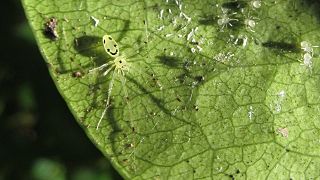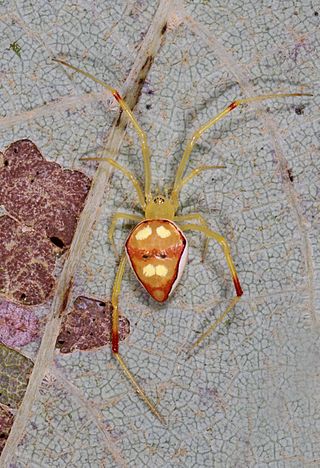
Latrodectus is a broadly distributed genus of spiders with several species that are commonly known as the true widows. This group is composed of those often loosely called black widow spiders, brown widow spiders, and similar spiders. However, the diversity of species is much greater. A member of the family Theridiidae, this genus contains 34 species, which include several North American "black widows". Besides these, North America also has the red widow Latrodectus bishopi and the brown widow Latrodectus geometricus, which, in addition to North America, has a much wider geographic distribution. Elsewhere, others include the European black widow, the Australian redback spider and the closely related New Zealand katipō, several different species in Southern Africa that can be called button spiders, and the South American black-widow spiders. Species vary widely in size. In most cases, the females are dark-coloured and can be readily identified by reddish markings on the central underside (ventral) abdomen, which are often hourglass-shaped.

Theridiidae, also known as the tangle-web spiders, cobweb spiders and comb-footed spiders, is a large family of araneomorph spiders first described by Carl Jakob Sundevall in 1833. This diverse, globally distributed family includes over 3,000 species in 124 genera, and is the most common arthropod found in human dwellings throughout the world.

The redback spider, also known as the Australian black widow, is a species of highly venomous spider believed to originate in South Australia or adjacent Western Australian deserts, but now found throughout Australia, Southeast Asia and New Zealand, with colonies elsewhere outside Australia. It is a member of the cosmopolitan genus Latrodectus, the widow spiders. The adult female is easily recognized by her spherical black body with a prominent red stripe on the upper side of her abdomen and an hourglass-shaped red/orange streak on the underside. Females usually have a body length of about 10 millimetres (0.4 in), while the male is much smaller, being only 3–4 mm (0.12–0.16 in) long.

Scaffold web spiders or cave cobweb spiders (Nesticidae) are a family of araneomorph spiders closely allied with tangle-web spiders (Theridiidae). Like the Theridiidae, these spiders have a comb of serrated bristles on the hind tarsi that are used to pull silk bands from the spinnerets. Nesticidae contains 16 genera and about 300 species, many of which are associated with caves or overhangs. The genus Nesticus is the type for the family and is found throughout the world. The related Eidmannella has speciated considerably in Texas caves and includes some extremely localized species that are considered threatened. One species, Eidmannella pallida, is found in caves and under overhangs, but also in agricultural fields and other habitats away from such restricted areas. The genus Carpathonesticus is found in central Eurasia.

Steatoda nobilis is a spider in the genus Steatoda, known in the United Kingdom as the noble false widow, as it superficially resembles and is frequently mistaken for the black widow and other spiders in the genus Latrodectus. It is often referred to as thefalse widow, although "false widow" is a more general term applied to a wider group of species with this resemblance. It is a moderately medically significant spider, with most bites resulting in symptoms similar to a bee or wasp sting. Some bites may cause more significant harm, partly due to pathogenic bacteria from the spiders.

Theridion grallator, also known as the Hawaiian happy-face spider, is a spider in the family Theridiidae that resides on the Hawaiian Islands. T. grallator gets its vernacular name of "Hawaiian happy-face spider" from the unique patterns superimposed on its abdomen, specifically those that resemble a human smiling face. T. grallator is particularly notable because of its wide range of polymorphisms that may be studied to allow a better understanding of evolutionary mechanisms. In addition to the variety of color polymorphisms present, T. grallator demonstrates the interesting quality of diet-induced color change, in which its appearance temporarily changes as it metabolizes various food items.

The spider genus Spintharus occurs from the northeastern United States to Brazil. Nicholas Marcellus Hentz circumscribed the genus in 1850, initially as a monospecific genus containing his newly described species S. flavidus.

Chrosiothes is a genus of comb-footed spiders that was first described by Eugène Louis Simon in 1894. It is considered a senior synonym of Theridiotis.

Anatea is an ant-mimicking genus of South Pacific comb-footed spiders that was first described by Lucien Berland in 1927. As of May 2020 it contains three species, found in Australia and on New Caledonia:
Paratheridula is a monotypic genus of comb-footed spiders containing the single species, Paratheridula perniciosa. The sole species was first described in 1886 under the name Theridion perniciosum. The genus was first described by Herbert Walter Levi in 1957, though it has been described under several different names, including Mysmena 4-maculata, Theridion quadrimaculatum, and Theridion arcadicum,

Theridula is a genus of cobweb spiders, found in many parts of the world. Species vary in size from 1 to 3.5 mm in length.

Steatoda capensis is a spider originating from South Africa. Its common names include the black cobweb spider, brown house spider, cupboard spider and due to its similarities to the katipō spider it is commonly known as the false katipō in New Zealand. Common throughout Southern Africa, it has been introduced into other countries and is now present in Australia and throughout New Zealand. It is a small spider, usually an all-over shiny black. It may have a small bright red, orange, or yellow patch near the tip of the abdomen along with a crescent shaped band near the front of the abdomen.

Nesticodes is a monotypic genus of comb-footed spiders containing only the red house spider [Nesticodes rufipes ]. It was first described by Allan Frost Archer in 1950, and has a pantropical distribution due to ship and air travel.

Phylloneta is a genus of comb-footed spiders formerly considered a sub-genus of Allotheridion, and raised to genus status in 2008. The type species was first described by Eugen von Keyserling in 1884 as Theridion pictipes. As of September 2019 it contains three species and two subspecies with a holarctic distribution: P. impressa, P. pictipes, P. sisyphia, P. s. foliifera, and P. s. torandae.

Ruborridion is a monotypic genus of Asian comb-footed spiders containing the single species, Ruborridion musivum. The species was first described under the name Theridion musivum in 1873. The genus was described by J. Wunderlich in 2011. They are found in India and in the mediterranean area
Tekellina is a genus of comb-footed spiders that was first described by Herbert Walter Levi in 1957.

Yunohamella is a genus of comb-footed spiders that was first described by H. Yoshida in 2007.
Keijiella is a genus of spiders in the family Theridiidae. It was first described in 2016 by Yoshida. As of 2017, it contains only one species, Keijiella oculiprominens, found in "China, Taiwan, Laos, Korea, Japan".
Bardala labarda is the only species in the monotypic genus Bardala, a member of the comb-footed spider family Theridiidae. It was first described by Michael I. Saaristo in 2006, and is endemic to the coral atoll of Aldabra.
Spintharus berniesandersi is a species of Spintharus in the family Theridiidae. It is endemic to Cuba. It was described in 2018 by Ingi Agnarsson and Lily Sargeant of the University of Vermont in a revision of the genus by Agnarsson and colleagues. S. berniesandersi was discovered alongside 14 other species of smiley-faced spiders. This revision is in contrast to Herbert Walter Levi's taxonomy, which considered it to be intraspecific variation within Spintharus flavidus.















